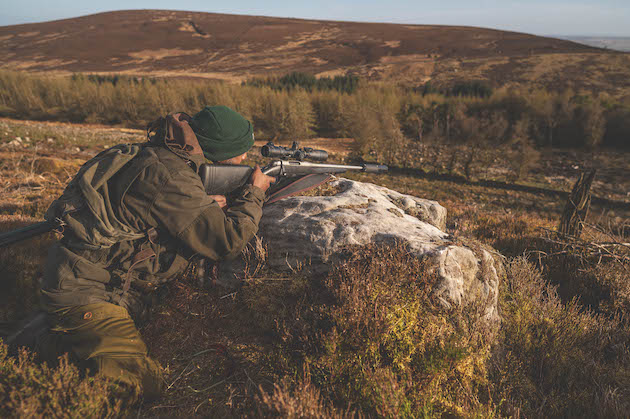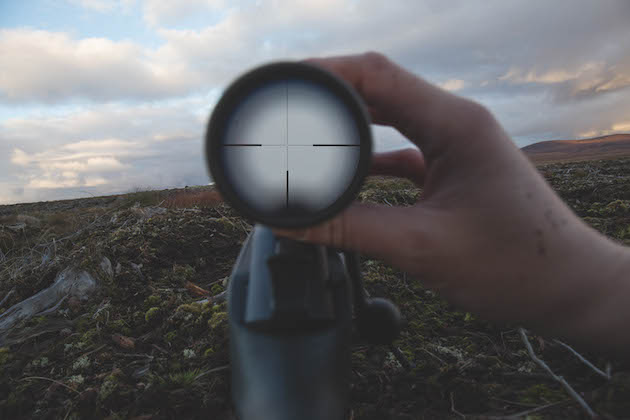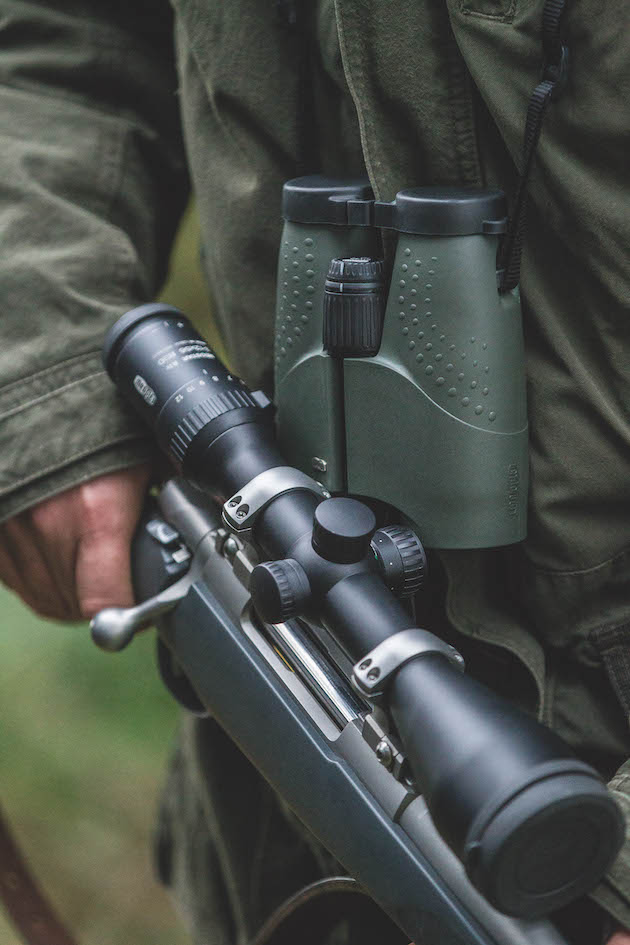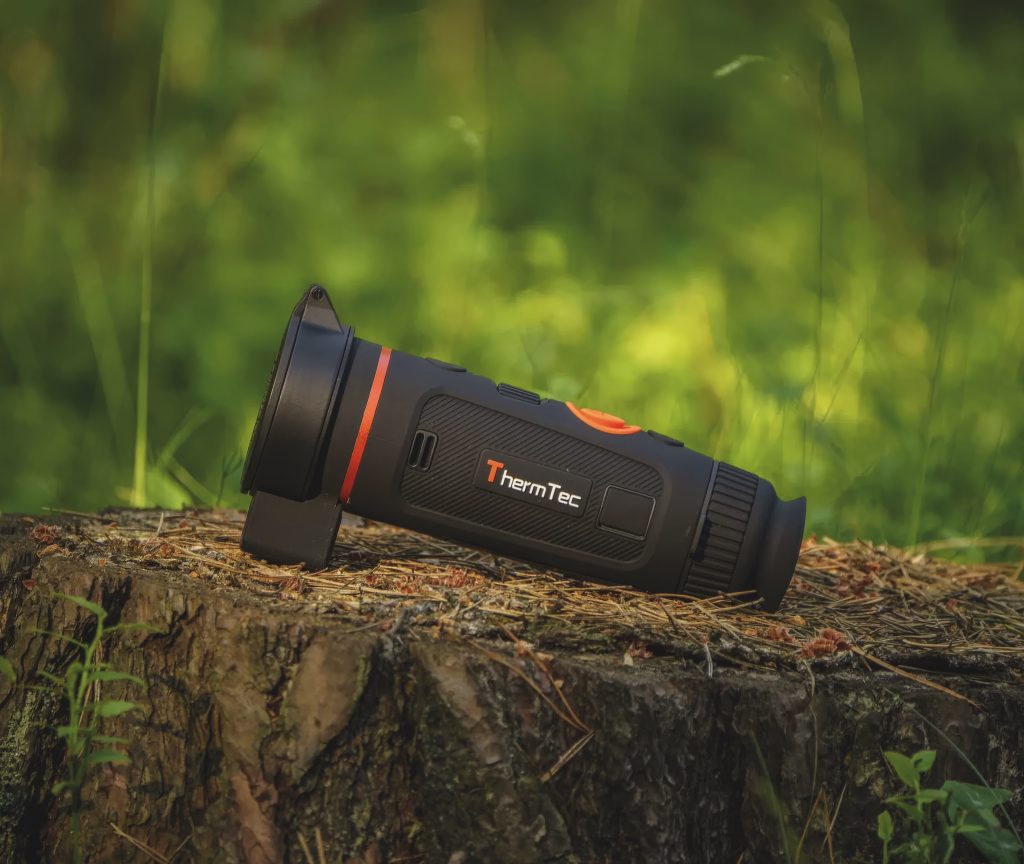Win CENS ProFlex DX5 earplugs worth £1,149 – enter here
How to choose a riflescope
 Taking position with the Steyr Mannlicher - Al sights through the Sightmark 4-16x44 scope
Taking position with the Steyr Mannlicher - Al sights through the Sightmark 4-16x44 scope
You don’t actually need much kit to go deerstalking. Binoculars to spot a beast and a rifle to bring it down are essential, but I would argue that a telescopic riflescope is the most important part of the set-up. There’s a reason why most stalkers advise spending more on a scope than a rifle. (Read our list of the best binoculars.)
A scope turns your rifle into a more accurate tool; it connects you to your quarry before you squeeze the trigger. It has to be reliable to ensure humane shot placement, and to withstand recoil, weather, knocks and being dragged through undergrowth and dirt when crawling into position.
Scopes haven’t changed much over the years, but at any gun shop you’ll be presented with a range of options. These scopes may have fixed or variable magnification, differing reticles (crosshairs), illuminated reticles (infrared or red dots), parallax adjustment, ballistic turrets and some rarer models can have built-in rangefinders.
The numbers might be confusing but they describe the magnification, followed by the diameter of the objective lens in millimetres.
The six-power scope was a popular choice with deerstalkers in the late 1990s, though many opted for an 8×56, which gave much better light gathering with its larger objective lens.
In the early 2000s, far more scope options appeared on the market. Variable scopes allowed the user to shoot the quarry on average from 2x to 12x magnification and illuminated reticles became the norm off the back of night-time boar shooting in Europe.

A good scope turns your rifle into a more accurate tool
Accurate
Magnification is probably the most important thing to consider when deerstalking. Don’t be fooled into thinking a higher magnification makes the scope better or your shooting more accurate. All my scopes are variable and I tend to use them on 7x almost all the time.
The lower mag capability is ideal when in thick woodland or following up a wounded deer that will need despatching at close range. I usually only turn the mag right up if shooting over 200m. One big problem when shooting deer on anything over 8x is that it significantly limits your field of view. The rifle recoil will prevent you seeing the reaction of the deer clearly through the scope. It will also make it more difficult to find the deer in the scope if a second shot is required — or you want to shoot more deer from the same group.

Scope and binoculars make a good team.
Precise
Most scopes now also come with an illuminated reticle, which is handy for shooting in low light conditions. While not essential in good daylight, they can be helpful, particularly because the modern crosshairs are very fine. This sometimes makes it hard to see the precise aiming spot on the deer. Many will have a day and night switch, and it’s worth setting the brightness of the night setting in advance in low light conditions — if you switch it on at full brightness while looking at a deer, you will blind yourself and not see the target clearly.
When using the red dot you want it to highlight the spot to hit, not to have it glowing at full strength. The other thing to remember with an IR is to switch it off when you have finished stalking. Most dots ‘sleep’ automatically when the rifle is held vertically, but I’ve heard of stalkers lining up for a shot only to find the battery has died on the way.
Scopes with a parallax adjustment are usually designed for very long-range shooting and as such the scope itself would zoom up to a very high magnification. The parallax allows you to focus the scope clearly at different ranges but if you do happen to get one, keeping it around the 100m mark should be fine for most stalking distances. I’d suggest steering away from these types of scopes for UK and average mountain hunting situations because they weigh a ton.
Most scopes now come with 1in tubes so bear that in mind when buying mounts. And remember that second-hand scopes may well have an older, smaller-diameter tube. In terms of mounts, there are various options, but I’ve simply always gone for the brand recommended by the rifle manufacturer.
If it’s your first scope, I’d suggest getting the gun shop to mount it for you and take the opportunity to get the scope the correct distance for your eye, once focused. Start by focusing the crosshairs while the scope is off the rifle against a plain background or the sky. Having done this, you can then set the scope on the rifle at the right distance for your eye. Set the distance for the most common way you will be shooting.
Level
Your stance will change slightly for different shooting positions. I mainly shoot off sticks, so I check the distance standing up. When you are happy, the shop can tighten the rings to secure the scope and make sure it’s level. If a scope is not level, any adjustments you make for bullet drop or windage won’t move straight, either vertically or horizontally. (Read our guide to the best shooting sticks.)
Once you are ready to zero your scope — and you have three types of different factory ammunition, as your rifle will prefer one more than the others — you can head to the range. At Euston we have some large 18in steel gongs, so we can remove the rifle bolt, line the barrel up with the gong at 100m and adjust the scope on to the steel so the first shot is clearly visible. This saves a lot of time and expensive ammo.
If you don’t have access to anything like this, you could use a large board or box. If using A4 paper, it’s best to go straight down to 20m. At this range your first shot should allow you to roughly adjust the scope to the centre before shooting again at 20m intervals back to your 100m zero distance.
Finally, a word on scope covers. You’ve spent a lot of money on the scope and you do need to protect the glass, particularly the ocular (eye end) lens. If you scratch this it may affect your viewing, whereas a scratched objective lens, while not good, is not the end of the world. There are many own-brand or independent makes of flip-up covers, but I have yet to see one that stands the test of time.
For this reason, the best option to keep lenses clean and dry are the basic bikini covers that come with the scope. Secure them on to the tube with two good-quality hairbands. If it’s a nice day, take them off and stalk with your scope ‘commando’. If it’s wet, leave them on.
Bikini covers are not much slower to remove than the flip-ups, and the hairband attachment means you won’t lose them. Let’s face it, what else would you do with hairbands other than use them to block up the washing machine filter.
Related Articles
Get the latest news delivered direct to your door
Subscribe to Shooting Times & Country
Discover the ultimate companion for field sports enthusiasts with Shooting Times & Country Magazine, the UK’s leading weekly publication that has been at the forefront of shooting culture since 1882. Subscribers gain access to expert tips, comprehensive gear reviews, seasonal advice and a vibrant community of like-minded shooters.
Save on shop price when you subscribe with weekly issues featuring in-depth articles on gundog training, exclusive member offers and access to the digital back issue library. A Shooting Times & Country subscription is more than a magazine, don’t just read about the countryside; immerse yourself in its most authoritative and engaging publication.







